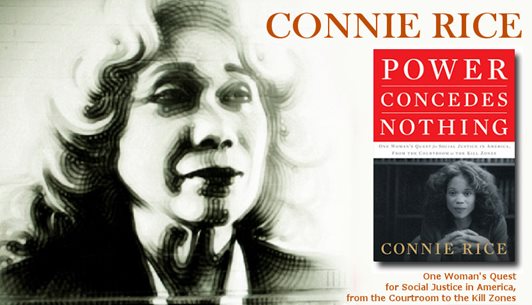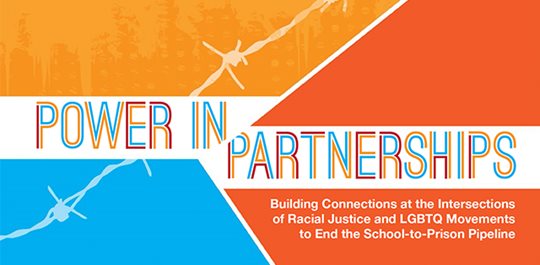“Power Concedes Nothing” is a memoir by a woman who is the kind of person I have always aspired to be – and I bet that’s true for many people reading this review or who will hear Connie Rice speak May 4 at the NeighborWorks Training Institute. I haven’t come anywhere close – despite my long career and many hours of volunteer work. But rather than being intimidating or discouraging as a result, Rice’s book serves as a clarion call to remember why we got involved in this work in the first place, as well as how much one person really can accomplish.

Rice is a civil rights attorney—best known by some as Condoleeza Rice’s second cousin, but who deserves to be at least as well known in her own right. Among the major themes of her book are identity, privilege and the necessity of going deep and broad—typically requiring linked arms with strange bedfellows—to confront systemic problems in a meaningful way (a strong endorsement of “housing plus”).
What is your identity?
Born one-fifth Native American, two-fifths African and two-fifths Scotch-Irish-Welsh Anglo-Saxon, Rice defies labels and could rightfully interact in society as something other than black. Clearly, the categories into which our culture tries to force people are more fluid than we feel comfortable admitting. Yet, African-American is how Rice identifies. At the same time, she acknowledges the fact that by virtue of the accident of birth—a family who has always done materially well for itself, extending back to antebellum days—she hails from a relatively privileged class from which many are excluded.Rice opens her book with a telling anecdote: She was 12 years old, and had just enrolled in a new school in a new state (Arizona)—a common occurrence for the “military brat.” A small, “black-as-coal” migrant kid marched up to to the light-skinned, self-acknowledged “princess” and demanded to know, “What is you?” Although she sputtered back that she was black, just like him, she realized for the first time that he was right. She wasn’t black like him.
“He was an undernourished, dark-skinned, ebonics-speaking son of migrant farmworkers,” Rice writes. “I, a light-skinned Black American Princess, spoke the King’s English and was the daughter of a highly educated biology teacher and a decorated Air Force officer. I was a tolerated token. He was the discarded ‘other’ consigned to the margins of society. His blood threatened white existence. Mine did not.”
Even more important than her remarkable degree of self-awareness (or rather, “other-awareness) was her response to the challenge. The 12-year-old girl wanted to know more about the divide that clearly separated them. After gaining the boy’s trust, she visited the tin-roof shack he called home. The young Connie came away not with pity, although her lifelong drive to make a difference for those who most in need started there. Rather, she came away with respect: “Shame burned up the sides of my face. Not for him, but for me. He owned nothing, but he had something I wanted. He had the grit and tenacity to claim a place the world had never intended for him to have.”
Learning by ‘going inside’
Her insights at such a young age reflect one of the defining tenets of NeighborWorks America—the inclusion of resident voices at the highest levels of our members’ structures: the board room.Rice went on to devote most of her career to creating a safe environment for families in the worst neighborhoods of Los Angeles. To plot the way, she put the philosophy she had learned as a child to work: When you need the guidance of an expert, go first to the people you want to help. Against the cautions of others who delivered help “to” instead of “with,” she asked the women who lived in the Jordan Downs neighborhood of the Watts project what they most needed. A few sobering facts to set the scene in 1992: Sixty percent of the males living there had been arrested or incarcerated. The risk of death by homicide was 500 times greater than in the neighborhood where Rice lived. Seventy-five percent of the older adults were functionally illiterate. The local high school senior class lost 75 percent of its students after the ninth grade.
 |
| Rice's Advancement Project focuses on breaking the school-to-prison pipeline |
When asked where Rice should start, the women of the neighborhood said they needed her help to stop their men—many of whom had joined gangs—from destroying themselves and so many others with violence. In fact, they said, they are meeting in a neighborhood trailer right now, debating a truce. Their challenge: Help us make it stick. And again, in her trademark style, Rice took a risk and knocked on that trailer door. What followed the months and years later was firsthand knowledge of what fuels gang membership, and what it takes to attract young men away: an alternative.
“Street gangs are a do-it-yourself vehicle for underclass males who have no access to mainstream jobs, upward mobility or power,” Rice notes, echoing a theme in the book, “Between the World and Me,” in which author Ta-Nehisi Coates notes that many behaviors that seem arrogant or hostile actually mask fear. “The turf is their identity. They yearn for a belonging that their broken families do not provide … [Yet] if it had been possible to do so, most would have traded their mean lives for a saner existence in a second. Under their masks of callous indifference, many secretly longed for exit ramps out of gang life…and away from prison. But shown those exit ramps, they need help in order to take them.”
Providing exit ramps
Helping them take those exit ramps, and stay there—particularly with jobs and sustainable housing—is a role that NeighborWorks members are increasingly taking on, primarily by helping individuals released from prison integrate back into the community. “Our failure to make viable jobs more common than jail cells has destroyed far more families than gangs,” notes Rice. “One long-term study showed that just one factor strongly correlates with significant reductions in gang violence: jobs. For hard-core gang members ready to change, jobs stop bullets.”Rice also devoted much of her early efforts to re-claim the “kill zones” of Los Angeles to suing the city’s police department, which had been rightfully reviled for rampant corruption, malpractice and downright abuse of people they were supposed to protect, but had literally been written off. Of course, the police were not the only ones at fault: Rice notes that in those early years, the city’s prevention programs were allocated only 24 cents a day per hot-zone child, while the municipality lavished $1 million per elephant for the zoo’s new preserve.
Today, Rice is no longer suing the LAPD, although she continues to fight to transform kill zones into healthy neighborhoods. To her credit, she has applied the same technique to the police department that she did to gangs—going inside to learn what shapes the culture, earning their grudging trust and becoming accepted as the best kind of change agent: perceived as a partner, rather than an adversary.
Today, Rice actually works from inside the LAPD and is the mastermind for its Community Safety Partnership, a specialized police unit dedicated to community policing in the public housing projects. In the CSP, cops are promoted for showing how they avoid arresting a teen and they get awards for demonstrating they bonds with people in the ghetto. In fact, after hearing from concerned doctors that several elderly residents had undiagnosed diabetes, CSP cops arranged for a trailer with doctors and equipment to visit and test everyone. And when a school principal reported that kids couldn’t afford the computers they needed, they raised money. As a result, President Obama appointed her to his Task Force on 21st Century Policing.
Lessons learned
So what lessons has Rice learned along the way, and would pass on to us?- Reject the inevitability of kill zones. We build them, and we can dismantle them.
- Leave the order of the courtrooms (and nonprofit offices) to take instruction from the streets.
- Push people beyond pilots to do the systemic change that complex problems require.
- Make adversaries into allies and, when necessary, sue (challenge) your friends, because it doesn’t matter who holds it—power concedes nothing without a demand.
- Reject false choices. There is no choice between fixing individuals, institutions or ecosystems; we have to fix them all.

